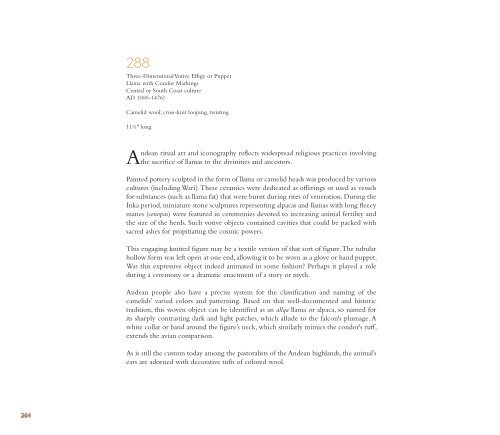Create successful ePaper yourself
Turn your PDF publications into a flip-book with our unique Google optimized e-Paper software.
288<br />
Three-Dimensional Votive Effigy or Puppet<br />
Llama with Condor Markings<br />
Central or South Coast culture<br />
AD 1000-1476?<br />
Camelid wool; cross-knit looping, twisting<br />
11½" long<br />
Andean ritual art and iconography reflects widespread religious practices involving<br />
<strong>the</strong> sacrifice of llamas to <strong>the</strong> divinities and ancestors.<br />
Painted pottery sculpted in <strong>the</strong> form of llama or camelid heads was produced by various<br />
cultures (including Wari). These ceramics were dedicated as offerings or used as vessels<br />
for substances (such as llama fat) that were burnt during rites of veneration. During <strong>the</strong><br />
Inka period, miniature stone sculptures representing alpacas and llamas with long fleecy<br />
manes (conopas) were featured in ceremonies devoted to increasing animal fertility and<br />
<strong>the</strong> size of <strong>the</strong> herds. Such votive objects contained cavities that could be packed with<br />
sacred ashes for propitiating <strong>the</strong> cosmic powers.<br />
This engaging knitted figure may be a textile version of that sort of figure. The tubular<br />
hollow form was left open at one end, allowing it to be worn as a glove or hand puppet.<br />
Was this expressive object indeed animated in some fashion? Perhaps it played a role<br />
during a ceremony or a dramatic enactment of a story or myth.<br />
Andean people also have a precise system for <strong>the</strong> classification and naming of <strong>the</strong><br />
camelids’ varied colors and patterning. Based on that well-documented and historic<br />
tradition, this woven object can be identified as an allqa llama or alpaca, so named for<br />
its sharply contrasting dark and light patches, which allude to <strong>the</strong> falcon's plumage. A<br />
white collar or band around <strong>the</strong> figure’s neck, which similarly mimics <strong>the</strong> condor's ruff,<br />
extends <strong>the</strong> avian comparison.<br />
As is still <strong>the</strong> custom today among <strong>the</strong> pastoralists of <strong>the</strong> Andean highlands, <strong>the</strong> animal’s<br />
ears are adorned with decorative tufts of colored wool.<br />
264







